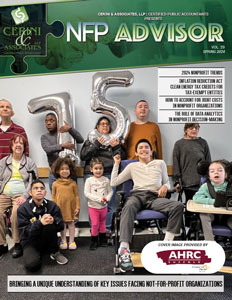A GUIDE TO APPLYING THE ACCOUNTING STANDARDS FOR ACTIVITIES THAT INCLUDE BOTH PROGRAM AND FUNDRAISING COMPONENTS.
WHAT ARE JOINT COSTS AND WHY ARE THEY IMPORTANT?
Joint costs are the costs of conducting activities that have more than one purpose or function, such as program, management and general, or fundraising. For nonprofit organizations (NFPs), joint costs can arise from events, publications, campaigns, or other activities that both serve their mission and provide fundraising opportunities. For example, a healthcare NFP may send a newsletter that educates the public about a disease and also solicits donations for research and treatment.
Joint costs are important because they affect how NFPs report their expenses by function in their financial statements. NFPs are required to present their expenses by function (such as program, management and general, and fundraising) and by natural classification (such as salaries, rent, and supplies). Functional expenses provide information about how NFPs use their resources to accomplish their missions and how efficiently they operate. NFPs are also subject to scrutiny from ratings agencies, donors, and the media, who use the percentage of expenses devoted to programming as a key indicator of NFP performance and accountability.
Therefore, NFPs need to ensure that they allocate joint costs appropriately and consistently, following the accounting standards and guidance that apply to this complex area. This article will explain the criteria, methods, and disclosures for accounting for joint costs in NFPs.
WHAT ARE THE CRITERIA FOR ALLOCATING JOINT COSTS?
Not all activities that include both program and fundraising components qualify for joint cost allocation. NFPs need to evaluate three criteria related to the purpose, audience, and content of the activity to determine if joint cost allocation is permitted. These criteria are based on the FASB Accounting Standards Codification (ASC) Subtopic 958-720, Not-for-Profit Entities–Other Expenses, which incorporates the guidance from the AICPA Statement of Position (SOP) 98-2, Accounting for Costs of Activities of Not-for-Profit Organizations and State and Local Governmental Entities That Include Fund Raising.
The purpose criterion is met if the purpose of the activity includes accomplishing program or management and general functions, and these functions meet the definitions in the ASC. Program functions should call for a specific action by the audience that benefits either the recipient individually or society as a whole. For example, a program function could be to educate the audience about a social issue, to advocate for a policy change, or to provide a service or assistance. Management and general functions are those that support the overall operations and governance of the NFP, such as administration, accounting, human resources, or board activities.
The purpose criterion can be assessed using three tests: the compensation-or-fees test, the separate-and-similar-activities test, and the other-evidence test. The compensation-or-fees test is a negative test that fails the purpose criterion if a majority of the compensation or fees for any party’s performance of any component of the activity is tied to contributions raised. For example, if a commission-based fundraiser is involved in any part of the activity, the purpose criterion is not met. The separate-and-similar-activities test can be used to meet the purpose criterion if a similar program or management and general activity is conducted separately and on a similar or greater scale. For example, if an NFP sends a newsletter that includes a fundraising appeal and also sends a similar newsletter without a fundraising appeal, the purpose criterion is met. The other-evidence test requires considering all available evidence, both positive and negative, to determine if the purpose criterion is met based on the weight of the evidence.
The audience criterion is met if the audience is selected based on its need to use or reasonable potential to use the action called for by the program or management and general component of the activity. For example, an NFP that provides legal services to low-income individuals may send a brochure that explains its services and also asks for donations to a list of potential clients who qualify for its assistance. The audience criterion is not met if the audience is selected based on its likelihood to contribute to the NFP, such as prior donors or wealthy individuals. The audience criterion may also not be met if the audience is too broad or general, such as the public at large, and does not have a specific need or potential for the program or management and general component.
The content criterion is met if the activity supports program or management and general functions by calling for a specific action by the audience that benefits either the recipient or society, and by explaining the need for and benefits of the action. For example, an NFP that promotes environmental conservation may send a video that shows the effects of climate change and also urges the audience to sign a petition and make a donation. The content criterion is not met if the activity only educates the audience about a cause or issue and does not call for a specific action. The content criterion may also not be met if the activity is incidental to the fundraising component, such as a thank-you note or a token gift.
HOW TO ALLOCATE JOINT COSTS?
Once an NFP determines that an activity meets the criteria for joint cost allocation, it needs to identify the joint costs and the allocation method. Joint costs are the costs of conducting the activity that are not identifiable with a particular component or function. For example, the cost of printing and mailing a brochure that includes both program and fundraising components is a joint cost. The cost of the staff time spent on preparing the program component of the brochure is not a joint cost and should be charged to program expenses.
The allocation method should be rational, systematic, and consistent, and should result in a reasonable allocation of joint costs. The ASC provides some examples of allocation methods, such as the physical-units method, the relative-direct-cost method, and the stand-alone joint-cost-allocation method. The physical-units method allocates joint costs based on the number of units of output, such as lines or square inches. The relative-direct-cost method allocates joint costs based on the relative direct costs of each component. The stand-alone method allocates joint costs based on what each component would cost if conducted separately. NFPs should choose the method that best reflects the benefits and costs of each component and apply it consistently to similar activities.
WHAT ARE THE DISCLOSURE REQUIREMENTS FOR JOINT COSTS?
NFPs that allocate joint costs are required to disclose the following information in their financial statements, according to ASC Paragraph 958-720-50-2:
- The types of activities for which joint costs have been incurred, such as newsletters, events, or campaigns.
- A statement that joint costs have been allocated among program, management and general, and fundraising functions.
- The total amount of joint costs allocated during the period.
- The amount of joint costs allocated to each functional expense category.
NFPs are also encouraged, but not required, to disclose the amount of joint costs for each kind of joint activity, if practical. For example, an NFP may disclose the joint costs allocated for each newsletter, event, or campaign that it conducted during the period.
IN SUMMARY
Joint cost accounting is a challenging and critical area for NFPs that conduct activities that include both program and fundraising components. NFPs need to follow the accounting standards and guidance that provide the criteria, methods, and disclosures for allocating joint costs. By doing so, NFPs can ensure that they report their functional expenses accurately and transparently, and that they demonstrate their efficiency and effectiveness in fulfilling their mission.

THIS ARTICLE WAS ALSO FEATURED IN NFP ADVISOR VOL. 29. READ THE ARTICLE AND MUCH MORE RELATED CONTENT HERE!

Mahnaz Cavalluzzi, CPA
Director
Mahnaz has been a member of Cerini & Associates’ audit and consulting practice area for over 8 years where she focuses on serving nonprofit organizations, education, and healthcare clientele. Mahnaz has experience in financial statement audits, financial statement reviews, tax return preparation, cost report filing, and other consulting. Mahnaz brings her expertise, diversified background, and helpful approach to all of her engagements.





No comment yet, add your voice below!